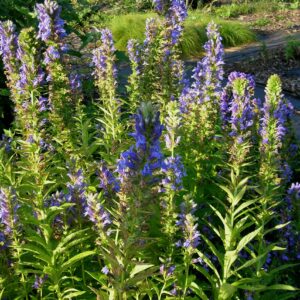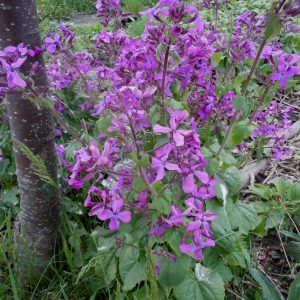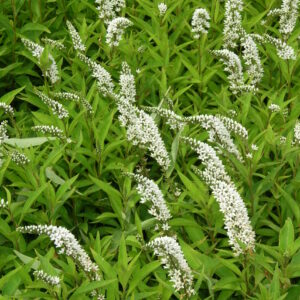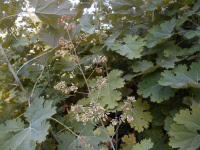Perennials & Biennials
Showing 297–304 of 485 results
-
Lobelia siphilitica Great lobelia Z 4-9
A striking, erect spike of sky to blueberry-blue blossoms. On top club-shaped buds, below trumpet-shapes, open flowers, made of a tube flaring open with the bottom divided into three, each segment pointed at the ends. From late summer to early fall.
A striking, erect spike of sky to blueberry-blue blossoms. On top club-shaped buds, below trumpet-shapes, open flowers, made of a tube flaring open with the bottom divided into three, each segment pointed at the ends. From late summer to early fall.
Size: 3' x 12"
Care: Full sun to part shade in moist to moist well-drained soil
Native: Connecticut to Wyoming, south to Texas then east to Georgia and all states in between, Wisconsin native.
Wildlife Value: attracts bumble bees, hummingbirds and some butterfliesLobelia is named for Matthias L’Obel (1538-1616) a French expatriate who emigrated to England and became physician to English King James I. Cherokee used the root to treat headaches, stomachaches, worms, nosebleeds, colds and syphilis. 1st collected by Rev. John Banister who moved to colonial Virginia in 1678. A gunman mistakenly shot and killed him while he collected plants. In 1749 Swedish botanist Peter Kalm wrote that Indians used five species of Lobelia to cure venereal disease, having “an infallible art of curing it.” According to John Bartram (1699-17760) “The learned Pehr Kalm (who gained the Knowledge of it from Colonel Johnson, who learned it of the Indians, who, after great Rewards bestowed on several of them, revealed the Secret to him) saith, That the Roots of this Plant cureth the Pox much more perfectly and easily than any mercurial Preparations, and is generally used by the Canada Indians, for the Cure of themselves“ (Better than mercury!) Oneidas considered this good medicine for distemper. Sioux treated bloat, diarrhea and dysentery as well as a love charm by adding powdered root to the food of the intended. Offered for sale in Bartram Garden’s 1783 Broadside, America’s 1st plant catalog.
-
Lunaria annua Money plant, Honesty, Silver dollar Biennial Reseeds Z 5-10
Mauve phlox-like blooms spring to early summer turn into silvery, translucent seedpods.
Mauve phlox-like blooms spring to early summer turn into silvery, translucent seedpods.
LIMITED QUANTITIES AVAILABLE, LIMIT OF 1 PER CUSTOMER PLEASE.
Size: 1'-3' x 1’
Care: Full sun to part shade.
Native: mountains of Italy
Wildlife Value: attracts bees and butterfliesOld-fashioned heirloom. Silver dollars are perfect for dried bouquets! Popular in winter flower arrangements since colonial times. Introduced to England from Germany in the late 1500’s and carried to America by the Puritans as a reminder of home. Grown at America’s 1st botanic garden, Elgin Botanic Garden 1811.
**LISTED AS OUT OF STOCK BECAUSE WE DO NOT SHIP THIS ITEM. IT IS AVAILABLE FOR PURCHASE AT OUR RETAIL LOCATION.
-
Lycoris squamigera Surprise lily, Naked lady Z 5-9
Strap-like leaves appear in April, then die back in summer. In August a shoot appears seemingly out-of-no-where, topped with pale pink trumpets. Flowers resemble Amaryllis.
Strap-like leaves appear in April, then die back in summer. In August a shoot appears seemingly out-of-no-where, topped with pale pink trumpets. Flowers resemble Amaryllis
Size: 18-24” x 6”
Care: full sun to part shade in moist well-drained soil
Native: JapanIntroduced to Western gardens from Japan in 1861 by Dr. George Rogers Hall (1820-1899), a physician who moved to Shanghai and became a trader, introducing several Japanese plants to the U.S.
-
Lysimachia clethroides Gooseneck loosestrife Z 3-8
White racemes looking like a goose neck from mid to late summer, deadhead to rebloom
White racemes looking like a goose neck from mid to late summer, deadhead to rebloom
Size: 36" x spreads
Care: sun to part shade in moist well-drained humusy soil
Native: China and Japan
Awards: England’s Royal Horticultural Society Award of MeritDioscorides (1st century A.D.) named Lysimachia after King Lysimachus of Thracia. This species collected before 1844.
-
Lysimachia nummularia ‘Aurea’ Creeping jenny Z 3-9
Bright yellow flowers in summer, chartreuse foliage which is the reason to grow this.
Bright yellow flowers in summer & chartreuse foliage which is the reason to grow this.
Size: 2” x spreading
Care: full sun to part shade in moist to moist well-drained soil
Native: Europe
Awards: England’s Royal Horticultural Society Award of Garden Merit.Dioscorides (1st century A.D.) named Lysimachia after King Lysimachus of Thracia. By the 1590’s used as cure for wounds and whooping cough. Species listed in Gardeners Dictionary, 1768. ‘Aurea’, H.H. Thomas 1915. Breck (1851) called this “suitable for rockwork or hanging from a pot in a northern exposure.” L.H. Bailey echoed this: “Very useful for rustic vases and baskets, also for carpeting ground in shady places.”
-
Macleaya cordata Plume poppy Z 4-9
An imposing plant - impressive, glaucous leaves with conspicuous veins and jagged margins, and, from July to October, tawny pink plumes.
An imposing plant – impressive, glaucous leaves with conspicuous veins and jagged margins, and, from July to October, tawny pink plumes.
Can not ship to: Delaware and Maryland
Size: 6-8' x 3' and spreading
Care: sun in well-drained to moist well-drained soil
Native: China and JapanEnglish seaman on Macartney’s Chinese mission sent this to Europe in 1792. In its native China the plant’s juice disinfected insect bites. Grown in American gardens since the 1800’s.
-
Malva alcea ‘fastiagata’ Hollyhock mallow Z 5-9
Bright rose mallows from early to late summer. Cut back by half in late July for rebloom.
OUT OF STOCK
Bright rose mallows from early to late summer. Cut back by half in late July for rebloom.
Size: 3’ x 18”
Care: Sun well-drained soil, drought tolerant
Native: ItalyMalvas have been cultivated for food or flower since 6000 B.C. In 1629 Parkinson described the uses for the Hollyhock mallow: “By reason of their viscous or slimie quality doe helpe to make the body soluble… helpe also to ease the paines of the stone and gravell, causing them to be the more easily voided: being outwardly applied, they mollisie hard tumors.”
-
Malva sylvestris ‘Zebrina’ Striped mallow – According to the books a perennial, but here it acts like an annual that reseeds – just watch for the seedlings in early summer. Z 5-8
June to October pink with purple striped mallow flowers
June to October pink with purple striped mallow flowers
Size: 36-48" x 24"
Care: Sun, moist well-drained soil. Moderately fertile.Malvas have been cultivated for food or flower since 6000 B.C. This was identified by Dioscorides in De Materica Medica for medicinal use around 70 A.D. Flowers and young leaves are edible – add petals to salads. The Malva sylvestris ‘Zebrina’ was listed as cultivated in the empire pursuant to Charlemagne’s Capitulare de Villis c. 800 A.D. The French word “mauve” comes from the color for this flower. Pressed specimen in Emily Dickinson’s herbarium.








